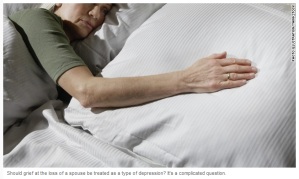Grieving the loss of a loved one can be one of the most difficult experiences of our lives. We may struggle with intrusive memories, difficulty concentrating, and prolonged feelings of emptiness. We may also desperately try to block out any memories of our loved one to spare ourselves the painful feelings, also known as avoidant grief.
However, blocking out feelings, according to a new collaborative study between Columbia Engineering and Columbia University Irving Medical Center, may ultimately exhaust our ability to cope effectively.
Using a machine-learning approach to functional magnetic resonance imaging (fMRI) called “neural decoding,” which establishes a neural pattern or fingerprint that can be used to determine when a given mental process is happening, researchers tracked the ongoing processes of mental control as loss-related thoughts came in and out of conscious awareness during a 10-minute period of mind-wandering in 29 subjects.
“The major challenge of our study was to be able ‘look under the hood’ of a person’s natural mind-wandering state to see what underlying processes were actually controlling their experience,” explains Noam Schneck, lead author of the study (Schneck, 2018).
All of the subjects in the study had lost a first-degree relative (a spouse or partner) within the last 14 months. While spontaneous fluctuations in their mental processes were monitored using fMRI, subjects performed a modified Stroop task, a test widely used in psychology to measure a person’s ability to control the contents of attention, and a separate task presenting pictures and stories of the deceased.
Schneck and his team discovered that those with more avoidant grief engaged their attentional control process to block representations of the deceased from conscious awareness (Schneck et al., 2018). Schneck explains, “Our findings show that avoidant grief involves attentional control to reduce the likelihood that deceased-related representations reach full conscious awareness. Even though they are not aware of it, avoidant grievers actively control their mental state so that spontaneous thoughts of loss do not enter their consciousness. This kind of tailoring of mind-wandering likely exhausts mental energy and leads to time periods when the thoughts actually do break through” (Schneck, 2018).
Schneck likens the process to an “ineffective pop-up blocker” that runs in the background of your computer. He says, “You might not be aware that it’s there but it slows down the overall operating speed and eventually breaks down and the pop ups get through” (Schneck, 2018).
“What we’ve shown is that outside of our conscious awareness, we are constantly editing our own mental experiences to control what does and does not get in. And this process of editing is not always helpful” (Schneck, 2018).
It is understandable that we may seek to avoid painful feelings, however, the point Schneck and his team make is that, ultimately, we cannot avoid painful feelings. As they say, “they do break through.” A better goal is perhaps to relax our conscious and unconscious mental controls of painful feelings and learn to accept them into our awareness.
Related Online Continuing Education (CE) Courses:
Grief: The Reaction to Loss is a 2-hour online continuing education (CE/CEU) course that teaches healthcare professionals how to recognize and respond to grief. Click here to learn more.
Caregiver Help: Depression and Grief is a 2-hour online video-based continuing education (CE/CEU) course that addresses caregiver depression and grief and provides strategies to help the caregiver cope. Click here to learn more.
—
Professional Development Resources is a nonprofit educational corporation 501(c)(3) organized in 1992. We are approved to sponsor continuing education by the National Board of Certified Counselors (NBCC); the Association of Social Work Boards (ASWB); the American Occupational Therapy Association (AOTA); the American Speech-Language-Hearing Association (ASHA); the Commission on Dietetic Registration (CDR); the Alabama State Board of Occupational Therapy; the Florida Boards of Social Work, Mental Health Counseling and Marriage and Family Therapy, Psychology & School Psychology, Dietetics & Nutrition, Speech-Language Pathology and Audiology, and Occupational Therapy Practice; the Georgia State Board of Occupational Therapy; the New York State Education Department’s State Board for Mental Health Practitioners as an approved provider of continuing education for licensed mental health counselors (#MHC-0135); the Ohio Counselor, Social Worker & MFT Board and Board of Speech-Language Pathology and Audiology; the South Carolina Board of Professional Counselors & MFTs; the Texas Board of Examiners of Marriage & Family Therapists and State Board of Social Worker Examiners; and are CE Broker compliant (all courses are reported within a few days of completion).
Professional Development Resources is approved by the American Psychological Association to sponsor continuing education for psychologists. Professional Development Resources maintains responsibility for this program and its content.
PDR offers over 150 accredited online CE courses for healthcare professionals.
Target Audience: Psychologists, School Psychologists, Counselors, Social Workers, Marriage & Family Therapists (MFTs), Speech-Language Pathologists (SLPs), Occupational Therapists (OTs), Registered Dietitian Nutritionists (RDNs), and Teachers
Enjoy 20% off all online continuing education (CE/CEU) courses @pdresources.org! Click here for details.













